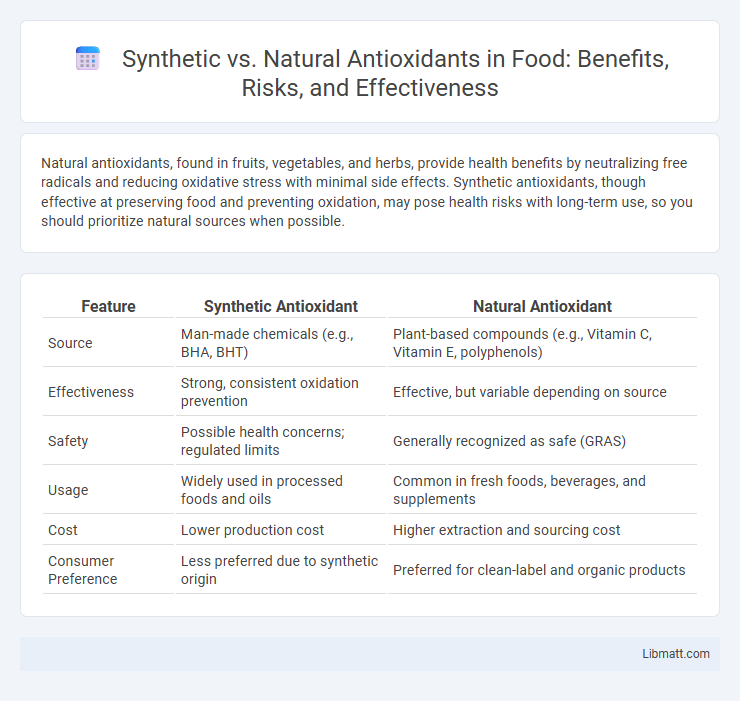Natural antioxidants, found in fruits, vegetables, and herbs, provide health benefits by neutralizing free radicals and reducing oxidative stress with minimal side effects. Synthetic antioxidants, though effective at preserving food and preventing oxidation, may pose health risks with long-term use, so you should prioritize natural sources when possible.
Table of Comparison
| Feature | Synthetic Antioxidant | Natural Antioxidant |
|---|---|---|
| Source | Man-made chemicals (e.g., BHA, BHT) | Plant-based compounds (e.g., Vitamin C, Vitamin E, polyphenols) |
| Effectiveness | Strong, consistent oxidation prevention | Effective, but variable depending on source |
| Safety | Possible health concerns; regulated limits | Generally recognized as safe (GRAS) |
| Usage | Widely used in processed foods and oils | Common in fresh foods, beverages, and supplements |
| Cost | Lower production cost | Higher extraction and sourcing cost |
| Consumer Preference | Less preferred due to synthetic origin | Preferred for clean-label and organic products |
Introduction to Antioxidants
Antioxidants are compounds that inhibit oxidation and protect cells from damage caused by free radicals. Natural antioxidants, found in fruits, vegetables, and herbs, provide essential nutrients like vitamins C and E along with polyphenols, while synthetic antioxidants are chemically manufactured substances such as BHA and BHT primarily used in food preservation. Understanding the differences between synthetic and natural antioxidants helps you make informed choices about health and dietary supplements.
Understanding Synthetic Antioxidants
Synthetic antioxidants are man-made compounds designed to prevent oxidation in food and cosmetic products by inhibiting free radicals and extending shelf life. Common synthetic antioxidants include BHA (butylated hydroxyanisole) and BHT (butylated hydroxytoluene), which are widely used due to their cost-effectiveness and stability. Understanding the chemical structure and potential health impacts of synthetic antioxidants helps you make informed choices between synthetic and natural options for your products or diet.
Exploring Natural Antioxidants
Natural antioxidants, derived from sources such as fruits, vegetables, and herbs, contain bioactive compounds like flavonoids, polyphenols, and vitamins that help neutralize free radicals and reduce oxidative stress. These antioxidants, including vitamin C, vitamin E, and carotenoids, are preferred due to their biocompatibility, safety profile, and additional health benefits like anti-inflammatory and immune-boosting properties. Research highlights their role in preventing chronic diseases, making natural antioxidants a vital component in functional foods and nutraceuticals.
Key Sources of Synthetic vs Natural Antioxidants
Synthetic antioxidants primarily originate from chemical compounds such as butylated hydroxytoluene (BHT), butylated hydroxyanisole (BHA), and propyl gallate, commonly used in processed foods and cosmetics to prevent oxidation. Natural antioxidants are found in fruits, vegetables, herbs, and spices, with key sources including vitamin C-rich citrus fruits, vitamin E-abundant nuts and seeds, and polyphenol-containing green tea and berries. Understanding the distinction between your synthetic and natural antioxidant sources empowers informed choices for health and nutrition.
Mechanism of Action: How Antioxidants Work
Synthetic antioxidants work by donating electrons to neutralize free radicals, preventing oxidative stress at a molecular level. Natural antioxidants, such as vitamins C and E, scavenge free radicals and also stimulate your body's endogenous defense systems to repair oxidative damage. Both types inhibit chain reactions that cause cellular damage, but natural antioxidants often provide additional benefits by modulating enzyme activity and gene expression.
Health Benefits of Synthetic and Natural Antioxidants
Synthetic antioxidants, such as BHA and BHT, are commonly used in food preservation and may provide consistent protection against oxidative damage but sometimes raise concerns over potential health risks with long-term use. Natural antioxidants like vitamins C and E, polyphenols, and flavonoids found in fruits, vegetables, and herbs offer proven health benefits by neutralizing free radicals, reducing inflammation, and supporting immune function. Your body can benefit more from natural antioxidants due to their additional bioactive compounds and fewer side effects compared to synthetic options.
Safety Concerns and Potential Risks
Synthetic antioxidants, such as BHA and BHT, have raised safety concerns due to potential toxic effects and links to cancer in some studies, prompting regulatory limits on their use. Natural antioxidants like vitamin C, vitamin E, and polyphenols are generally regarded as safer, with lower toxicity and additional health benefits, but they may be less stable in food products. Understanding these potential risks helps you make informed choices about antioxidant intake and product selection for health and safety.
Regulatory Guidelines and Approvals
Regulatory guidelines for synthetic antioxidants typically involve rigorous safety assessments by agencies like the FDA and EFSA, requiring comprehensive toxicological data to ensure consumer safety. Natural antioxidants, often recognized as Generally Recognized As Safe (GRAS), undergo evaluation based on their traditional use and scientific evidence of efficacy and safety. Approval processes for both types emphasize concentration limits, labeling requirements, and continuous monitoring to prevent adverse health effects.
Current Research and Scientific Findings
Current research indicates that natural antioxidants, derived from fruits, vegetables, and herbs, contain complex mixtures of bioactive compounds providing synergistic health benefits and lower toxicity compared to synthetic antioxidants like BHT and BHA. Scientific findings highlight that synthetic antioxidants are often more stable and effective in food preservation, but concerns about their long-term safety have prompted increased investigation into natural alternatives. Your choice between synthetic and natural antioxidants should consider efficacy, safety profiles, and ongoing advancements in extraction technologies enhancing natural antioxidant potency.
Choosing the Right Antioxidant for Optimal Health
Selecting the right antioxidant between synthetic and natural sources significantly impacts your health optimization efforts. Natural antioxidants, rich in vitamins C, E, and polyphenols found in fruits and vegetables, offer comprehensive benefits by combating oxidative stress and reducing inflammation more effectively than many synthetic alternatives. Your choice should prioritize bioavailability, safety profiles, and long-term effects, with natural antioxidants generally preferred for supporting cellular health and preventing chronic diseases.
Synthetic Antioxidant vs Natural Antioxidant Infographic

 libmatt.com
libmatt.com